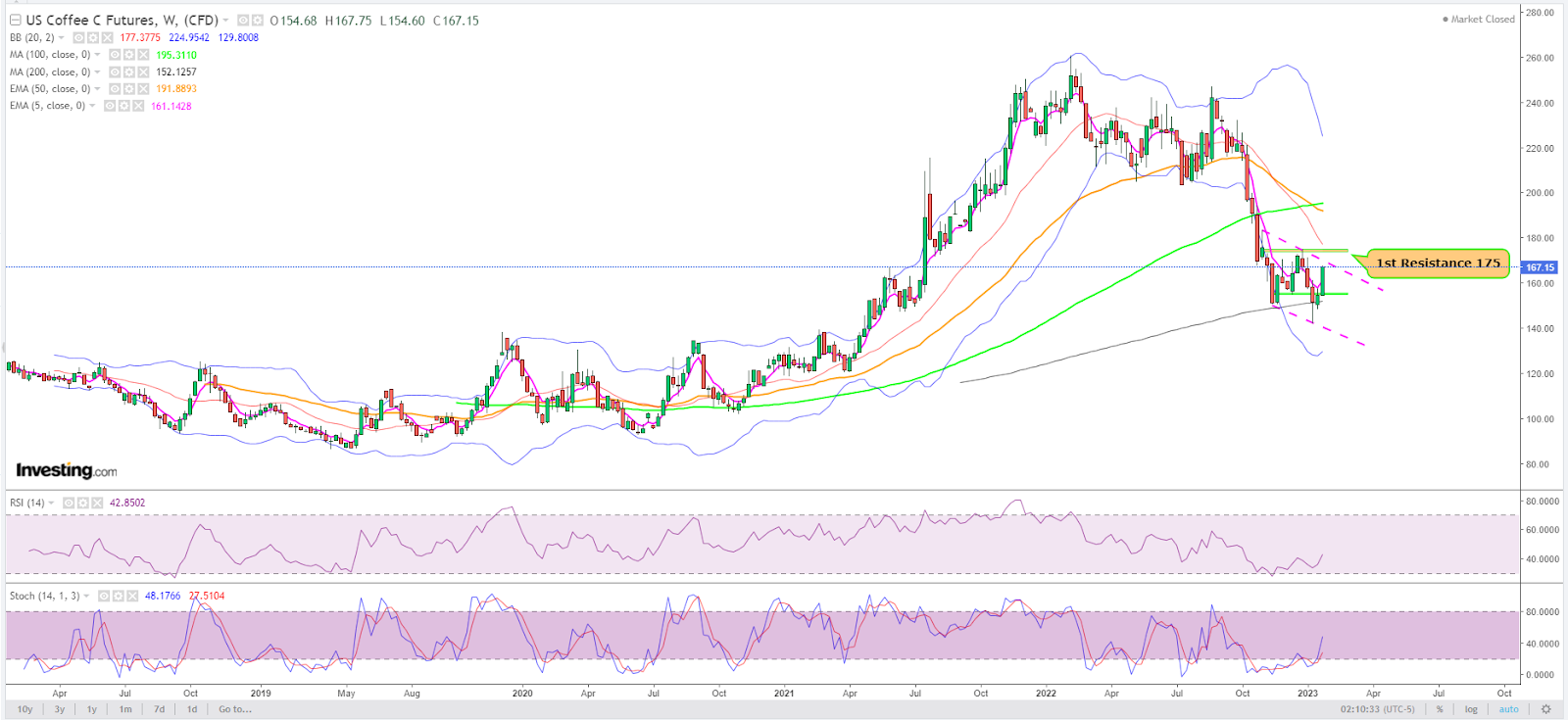Coffee Steaming Again After 4 Months in the Cold
KC
+1.26%
Add to/Remove from Watchlist
Add to Watchlist
Add Position
Position added successfully to:
Please name your holdings portfolio
Type:
BUY
SELL
Date:
Amount:
Price
Point Value:
Leverage:
1:1
1:10
1:25
1:50
1:100
1:200
1:400
1:500
1:1000
Commission:
Create New Watchlist
Create
Create a new holdings portfolio
Add
Create
+ Add another position
Close
SBUX
+0.77%
Add to/Remove from Watchlist
Add to Watchlist
Add Position
Position added successfully to:
Please name your holdings portfolio
Type:
BUY
SELL
Date:
Amount:
Price
Point Value:
Leverage:
1:1
1:10
1:25
1:50
1:100
1:200
1:400
1:500
1:1000
Commission:
Create New Watchlist
Create
Create a new holdings portfolio
Add
Create
+ Add another position
Close
- Arabica hit a 3-week high after the 20-month bottom of $1.42 a lb on Jan. 11
- Production in top coffee grower Brazil is overrated, say analysts
- Trader Volcafe says world expected to face 3rd straight year of coffee shortage
‘Wake up and smell the coffee,’ the saying goes.
You should probably be checking out the charts of arabica, too — the top bean for the commodity — while doing that.
After four months in the cold, arabica prices are steaming again, with the benchmark March contract on ICE Futures U.S. hitting a three-week high of $1.68 a lb on Thursday after a 20-month bottom of $1.42 per lb on Jan. 11.
Arabica has rallied 10% over the past two weeks — recovering most of its 12% drop over three prior weeks — on concerns about the crop in top coffee grower Brazil.  Arabica Weekly Chart
Arabica Weekly Chart
On a monthly basis, arabica prices are flat for January, after deficits of 0.2% in December, 5.6% in November, 19.8% in October, and 7.3% in September.
Said Jack Scoville, chief crop analyst at Chicago brokerage Price Futures Group:
“There are ideas that production potential for Brazil had been overrated.
The weather in Brazil is currently very good for production potential, but worse conditions seen earlier in the growing cycle hurt the overall production prospects as did bad weather last year.”
Arabica’s spurt higher comes after coffee trader Volcafe cautioned a week ago that the world would face a shortage in the commodity for a third year in a row due to a lower-than-expected harvest from top grower Brazil.
ED&F Man’s coffee division said in a January report carried by Bloomberg that global coffee supply will likely trail demand by 3.8 million bags in the next season, with the robusta beans used in instant coffee and as a blend in espressos potentially seeing a record shortfall amid surging demand.
The shortfall comes after demand in the current season is seen as outstripping supply by 4.5 million bags, according to the firm.
Adds Volcafe:
“This would imply an unprecedented third consecutive deficit. We expect the tightest period to begin from August 2023 and continue into 2024, with global stocks, especially robusta, falling to record lows.”
Aside from the robusta deficit that could make even traditional brands at the supermarket more costly for consumers, Brazil is also expected to harvest less arabica, the bean favored by Starbucks (NASDAQ:SBUX), which could translate into higher prices at coffee chains and cafes.
Arabica futures reached a decade high in February 2022 following two sub-par crops in Brazil and Colombia and global shipping disruptions. Prices have fallen almost 40% since then, brought down in part by market speculation that Brazilian growers will be gathering a record arabica crop this year.
Brazil now has the potential to only produce 40.5 million bags of arabica for the harvest starting in May, down from a July forecast of 49.8 million bags, Volcafe said, citing blossom issues in key areas of Brazil’s Minas Gerais state, the world’s biggest arabica producing region. The firm also trimmed estimates for the 2022-23 season by 1.1% due in part to frost damage.
Arabica has traditionally been the most popular variety of coffee, but Volcafe said that robusta accounted for 48% of global demand last year, reflected in the tightening supply of the less costly bean type. Arabicas usually command a premium over robustas, but in the past year, that spread has been cut in half amid a shift in blends toward cheaper grades.
The trend of using more robusta is expected to continue as inflation and slowing economic growth spur cost-conscious consumers to less expensive options.
Indonesia, the third-ranked robusta producer, is also expected to see its smallest robusta crop in 10 years next season due to damage from excessive rainfall across its major growing regions. That’ll weigh on the variety’s global deficit, which is forecast to double to 5.6 million bags next season. A bag weighs 60 kilograms.
Volcafe added:
“We predict strong global robusta usage to continue until a sizable shift back to arabica is incentivized either by consumer demand or relative price,”
So, what do arabica’s technical charts say? How well could the premium coffee bean do from here? Arabica Daily Chart
Arabica Daily Chart
A test of $1.83, a level last seen in November, could be on the cards next, says Sunil Kumar Dixit, chief technical strategist at SKCharting.com.
He adds:
“Coffee futures weekly chart shows bullish consolidation above the support line of a descending channel which may break above channel resistance line.”
Dixit said arabica’s short-term outlook remains bullish, supported by the 5-Day Exponential Moving Average, or EMA, of $1.62 that crosses over into the Daily Middle Bollinger Band of $1.59 and could overlap with the 50-Day EMA of $1.63.
“Going further, $1.83 will pose the next challenge for coffee bulls.”
On the flip side, if arabica turned lower, short term support will likely be reestablished at $1.55, he said.
Disclaimer:





